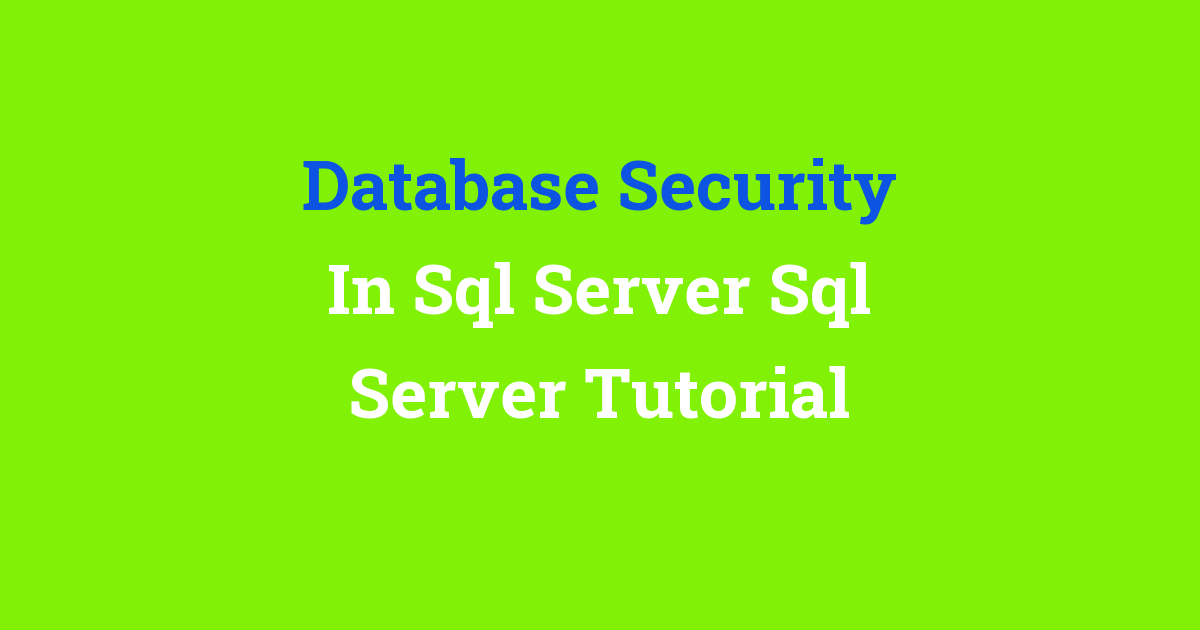SQL Server tutorial on how to ensure database security in SQL Server.
Database Security in SQL Server
Introduction
In the world of technology, data security is of utmost importance. With the increasing number of cyber-attacks and data breaches, it has become essential to ensure the security of databases. SQL Server is a popular database management system used by many organizations to store and manage their data. In this project, we will discuss the importance of database security in SQL Server and propose a new system to enhance security measures.
Problem Statement
The existing system of database security in SQL Server may have vulnerabilities that can be exploited by hackers to gain unauthorized access to sensitive data. The traditional security measures such as passwords and encryption may not be enough to protect the database from sophisticated cyber threats. There is a need for a more robust and advanced system that can detect and prevent security breaches effectively.
Existing System
The existing system of database security in SQL Server includes features such as user authentication, data encryption, and role-based access control. While these features are essential for securing the database, they may not be enough to protect against advanced cyber-attacks. Hackers can use various methods such as SQL injection and cross-site scripting to exploit vulnerabilities in the system and gain unauthorized access to the database.
Disadvantages
Some of the disadvantages of the existing system of database security in SQL Server are:
1. Vulnerabilities: The system may have vulnerabilities that can be exploited by hackers to gain unauthorized access to the database.
2. Limited protection: The traditional security measures may not provide sufficient protection against advanced cyber threats.
3. Compliance issues: The system may not comply with industry regulations and standards for data security.
4. Complexity: Managing and maintaining the security measures in the system can be complex and time-consuming.
Proposed System
To address the shortcomings of the existing system, we propose a new system that includes the following features:
1. Multi-factor authentication: Implementing multi-factor authentication can enhance the security of the database by requiring users to provide multiple forms of verification before accessing the data.
2. Advanced encryption: Using advanced encryption algorithms can protect the data stored in the database from unauthorized access.
3. Intrusion detection system: Implementing an intrusion detection system can help detect and prevent security breaches in real-time.
4. Security auditing: Conducting regular security audits can identify vulnerabilities in the system and take necessary measures to strengthen security.
5. Role-based access control: Assigning specific roles and permissions to users can control access to the database and prevent unauthorized activities.
Advantages
Some of the advantages of the proposed system of database security in SQL Server are:
1. Enhanced security: The new system provides enhanced security measures to protect the database from cyber threats.
2. Real-time monitoring: The intrusion detection system allows for real-time monitoring of security breaches and quick response to prevent data loss.
3. Regulatory compliance: The system ensures compliance with industry regulations and standards for data security.
4. Simplified management: The system offers user-friendly interfaces for managing and maintaining security measures in the database.
5. Improved data protection: The advanced encryption algorithms ensure the protection of data stored in the database from unauthorized access.
Features
The features of the proposed system of database security in SQL Server include:
1. Multi-factor authentication: Enhances security by requiring users to provide multiple forms of verification.
2. Advanced encryption: Protects data stored in the database from unauthorized access.
3. Intrusion detection system: Detects and prevents security breaches in real-time.
4. Security auditing: Conducts regular security audits to identify vulnerabilities in the system.
5. Role-based access control: Controls access to the database by assigning specific roles and permissions to users.
Conclusion
In conclusion, database security in SQL Server is essential to protect sensitive data from cyber threats. The existing system may have vulnerabilities that need to be addressed with a more robust and advanced system. The proposed system includes features such as multi-factor authentication, advanced encryption, intrusion detection system, security auditing, and role-based access control to enhance security measures in the database. By implementing these measures, organizations can ensure the security and integrity of their data in SQL Server.

